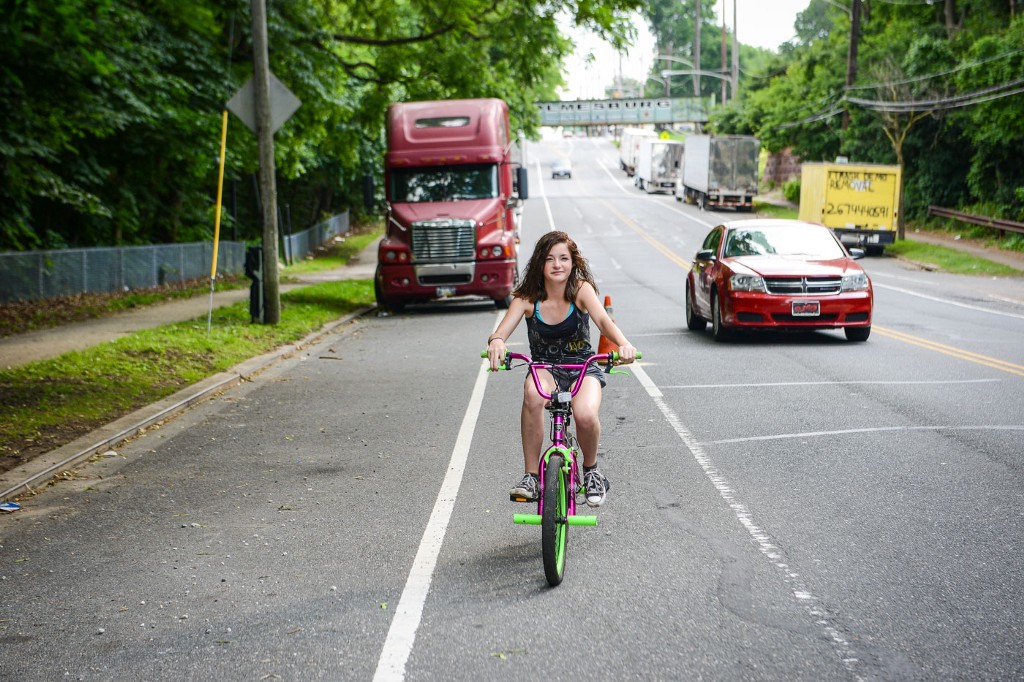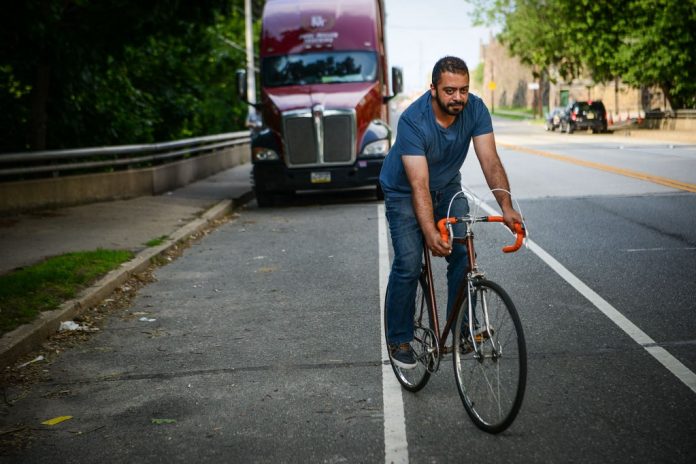Share the road: Yazan Abulaimoun rides his bike on one of the city’s many bike lanes. Planned improvements to the city’s 68 miles of lanes include more than 10 miles of new lanes and barriers separating some lanes from motor vehicle traffic. MARIA POUCHNIKOVA / TIMES PHOTO
The Northeast is positioned to become the testing ground for a new strategy in Philadelphia’s zealous effort to become the most bikeable city in America.
But despite enthusiastic advocacy from the Bicycle Coalition of Greater Philadelphia, a local councilman and even Mayor Michael Nutter’s home office — in the person of his cycling-mad wife, Lisa Nutter — the administration’s latest plan to include two so-called “protected lanes” among dozens of miles of bike lane improvements has drawn more than a smattering of criticism, and not just from motorists who would rather hog local roads for themselves.
Last month, Department of Streets Commissioner David J. Perri announced that work crews will install or “refresh” 68 miles of bicycle lanes throughout the city as part of his department’s 2015 roadway paving program. The improvements will include more than 10 miles of new bike lanes, two segments of which will be configured with barriers and/or parking lanes separating the bike lanes from motor vehicle traffic.
One protected lane will be on Ryan Avenue between Rowland and Lexington avenues in Mayfair. Another will cover a short distance of Frankford Avenue in Upper Holmesburg, connecting two portions of the Pennypack Park recreational path. But even bicyclists aren’t sold on the concept.
“So-called ‘parking-protected’ bike lanes are the worst kind of cycletrap (sic), as they hide bicyclists and motorists from each other’s lines of sight until the instant they collide at crossings and intersections,” wrote Justin McMurty in the online comments section of a May 26 Philadelphia magazine article. “Furthermore, such facilities are constantly being used and crossed by pedestrians, often on their way to or from the parked cars. Magical ‘protection’ is a nice fantasy, but the reality is that these facilities are inherently dangerous to bicyclists.”
Another commenter, Bill Sellin, agreed: “A ‘protected bike lane’ does not exist — it is a separated bikeway — or ‘cycletrap.’ (sic) You can’t get out to merge with other traffic, and when cities make them 2-way facilities, half the users will be going the wrong way with very challenging intersection conflicts.”
Their concerns hold water when one considers the 551 bicycle crashes reported in Philadelphia last year, according to PennDOT statistics cited by Philly mag. That’s despite the city’s more than 230 established bicycle lanes, in addition to marked shared lanes (that is, streets where pavement markings indicate that motorists must share the road with bicyclists). The city developed its first Bicycle Network Plan in 2000 and released its reworked Pedestrian and Bicycle Plan in 2012. The latter is accessible on the City Planning Commission website.
However, protected bike lanes will be a first. Jeannette Brugger, the city’s bicycle and pedestrian coordinator, told the Northeast Times that the protected lanes remain in design and that there are multiple options. One configuration places the bike lane between the curb and a lane reserved for parallel car parking. Another option is to place a vertical component between the bicycle lane and motor traffic lane, such as humps or delineator posts (those reflective orange posts, usually made of plastic, that collapse when struck by a car or other vehicle). The city is already using delineator posts to control some intersections, such as Springfield and Baltimore avenues in West Philly, Brugger said.
A protected lane may use a combination of parked cars and a vertical component and typically will further incorporate street markings and buffer zones to mitigate the dangers of sudden car-door openings and other obstacles.
“That is a concern. We build in a buffer in parking protected lanes so there is a ‘door zone,’ ” said Brugger, who characterized the options as a “tool box” upon which engineers may draw depending on the constraints of the roadway, traffic volumes and other factors.
The 2015 roadway paving program also calls for new bicycle facilities on Frankford, Grant, Linden and Loretto avenues, along with Orthodox Street in the Northeast. Orthodox, Loretto and Linden all need new bike lanes to fill gaps in the existing network. Frankford and likely Grant will be marked with “sharrows” designating each as a bicycle route where motorists are required to share a lane of travel with cyclists.
Even on roadways (except highways) where there are no bicycle markings, cyclists have equal access and responsibilities under Pennsylvania law. Bicyclists are required to ride with the flow of traffic and generally must stay to the right, unless turning or avoiding obstacles.
The aforementioned Philadelphia article and an article posted on the Bicycle Coalition’s website last month each reported that Councilman Bobby Henon has advocated for protected bike lanes in his district. Lisa Nutter has been a well-documented bicycle network advocate, too. In February, USA Cycling featured her in an article, detailing the first lady’s recent exploits as a competitive track cyclist.
But even with that clout, the new protected bike lanes could be in for a rough ride if other major cities are any indication.
In Newark, New Jersey, Mayor Ras Baraka ordered the removal of that state’s first protected bike lane last December in response to complaints from local merchants, according to the WalkBikeJersey Blog, which cited several articles by a critical Star-Ledger columnist for energizing opposition, not unlike Philly has seen from one of its own daily newspaper columnists for years.
Public response has been more favorable in other cities, according to published reports compiled by Streetsblog.net. In April, Seattle officials presented conceptual plans to the community for protected lanes. Last August, Houston officials announced a plan for a protected lane in that city’s downtown area. Earlier last year, business owners in Portland and Chicago publicly lobbied city officials for the installation of protected lanes.
Brugger, Philadelphia’s bike and pedestrian coordinator, did not identify a specific timetable for the city’s new protected lanes or any of the bike lane improvements, stating only that the 2015 paving season will progress, weather permitting, throughout the summer and fall. ••

Safety first: Brianna Donahue, 13, rides her bike alongside Pennypark Park on Torresdale Avenue in Holmesburg. The city’s attempt to redesign some bike lanes has met criticisms. MARIA POUCHNIKOVA / TIMES PHOTO





